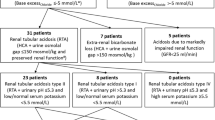Abstract
Background
Amelioration of hyperchloremic acidosis (Cl-Ac), a common complication in chronic kidney disease (CKD), could preserve renal function in chronic kidney disease (CKD). However, the development of Cl-Ac in CKD has not been clarified yet.
Methods
The degree of Cl-Ac, which is indicated as the bicarbonate concentration decrease with serum chloride concentration increase (∆[HCO3–]Cl), was compared with the estimated glomerular filtration rate (eGFR) by using CKD patient records.
Results
In 307 records with metabolic acidosis, a spline curve obtained from the plot comparing ∆[HCO3–]Cl with eGFR showed that ∆[HCO3–]Cl did not change, increased, and decreased during eGFR decrease until 27, from 27 to 17.5, and from 17.5 mL/min/1.73 m2, respectively.
Conclusion
By CKD progression, Cl-Ac progressed and regressed at the CKD stages G4 and G5, respectively. The regression would have reflected the shift of Cl-Ac to high anion gap acidosis.


Similar content being viewed by others
References
Hamm LL, Nakhoul N, Hering-Smith KS. Acid-base homeostasis. Clin J Am Soc Nephrol. 2015;10:2232–42.
Kraut JA, Madias NE. Metabolic acidosis of CKD: an update. Am J Kidney Dis. 2016;67:307–17.
Nagami GT, Hamm LL. Regulation of acid-base balance in chronic kidney disease. Adv Chronic Kidney Dis. 2017;24:274–9.
Phisitkul S, Khanna A, Simoni J, Broglio K, Sheather S, Rajab MH, Wesson DE. Amelioration of metabolic acidosis in patients with low GFR reduced kidney endothelin production and kidney injury, and better preserved GFR. Kidney Int. 2010;77:617–23.
de Brito-Ashurst I, Varagunam M, Raftery MJ, Yaqoob MM. Bicarbonate supplementation slows progression of CKD and improves nutritional status. J Am Soc Nephrol. 2009;20:2075–84.
Ray S, Piraino B, Chong TK, el-Shahawy M, Puschett JB. Acid excretion and serum electrolyte patterns in patients with advanced chronic renal failure. Miner Electrolyte Metab. 1990;16:355–61.
Hakim RM, Lazarus JM. Biochemical parameters in chronic renal failure. Am J Kidney Dis. 1988;11:238–47.
Widmer B, Gerhardt RE, Harrington JT, Cohen JJ. Serum electrolyte and acid base composition. The influence of graded degrees of chronic renal failure. Arch Intern Med. 1979;139:1099–102.
Miller WG, Jones GRD. Estimated glomerular filtration rate; laboratory implementation and current global status. Adv Chronic Kidney Dis. 2018;25:7–13.
Figge J, Jabor A, Kazda A, Fencl V. Anion gap and hypoalbuminemia. Crit Care Med. 1998;26:1807–10.
Tanemoto M. Calculated bicarbonate for acid-base disorders. Am J Med. 2017;130:1135–6.
Berend K, de Vries AP, Gans RO. Physiological approach to assessment of acid-base disturbances. N Engl J Med. 2014;371:1434–45.
Matsuo S, Imai E, Horio M, Yasuda Y, Tomita K, Nitta K, Yamagata K, Tomino Y, Yokoyama H, Hishida A. Collaborators developing the Japanese equation for estimated GFR. Revised equations for estimated GFR from serum creatinine in Japan. Am J Kidney Dis. 2009;53:982–92.
Sabatini S. The acidosis of chronic renal failure. Med Clin North Am. 1983;67:845–58.
DuBose TD Jr. Acid-base physiology in uremia. Artif Organs. 1982;6:363–9.
Tanemoto M. Gap acidosis except lactic acidosis develops and progresses during chronic kidney disease stage G5. Clin Exp Nephrol. 2019;23:1045–9.
Rojas-Vega L, Gamba G. Mini-review: regulation of the renal NaCl cotransporter by hormones. Am J Physiol Renal Physiol. 2016;310:F10–F1414.
Remer T. Influence of nutrition on acid-base balance–metabolic aspects. Eur J Nutr. 2001;40:214–20.
Author information
Authors and Affiliations
Corresponding author
Ethics declarations
Conflict of interest
The authors have no conflicts of interest to declare.
Ethical standards
The study was conducted in accordance with the guidelines written in the Declaration of Helsinki. The study was approved by the ethics committee of Shin-Kuki General Hospital (Approved number 0002) and written informed consent from individual patients was waived.
Additional information
Publisher's Note
Springer Nature remains neutral with regard to jurisdictional claims in published maps and institutional affiliations.
About this article
Cite this article
Tanemoto, M., Kamachi, R., Kimura, T. et al. Hyperchloremic acidosis develops at the stage G4 and shifts to high anion gap acidosis at the stage G5 in chronic kidney disease. Clin Exp Nephrol 24, 1140–1143 (2020). https://doi.org/10.1007/s10157-020-01949-x
Received:
Accepted:
Published:
Issue Date:
DOI: https://doi.org/10.1007/s10157-020-01949-x




